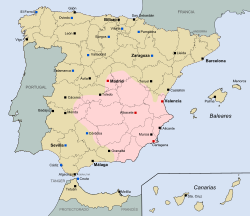
Back الهجوم الأخير في الحرب الأهلية الإسبانية Arabic Апошняе наступленне (1939) Byelorussian Последна офанзива в Гражданската война в Испания Bulgarian Ofensiva final Spanish Offensive finale de la guerre d'Espagne French Ofensiva final da Guerra Civil Espanhola Portuguese Последнее наступление (1939) Russian
| Final offensive of the Spanish Civil War | |||||||
|---|---|---|---|---|---|---|---|
| Part of the Spanish Civil War | |||||||
 Map of Spain in February 1939.
| |||||||
| |||||||
| Belligerents | |||||||
|
|
| ||||||
| Commanders and leaders | |||||||
|
Negrín's Government: Council of National Defense: |
| ||||||
| Strength | |||||||
|
250,000[2]−500,000 men[3] 40 aircraft |
1,000,000 men[4] 600 aircraft | ||||||
| Casualties and losses | |||||||
|
Casado's coup: 230[5]–2,000 killed[6] Final offensive: 150,000 captured[7] | 1,476 killed (sinking of the Castillo de Olite)[8] | ||||||
| Events leading to World War II |
|---|
The final offensive of the Spanish Civil War took place between 26 March and 1 April 1939, towards the end of the Spanish Civil War. On 5 March 1939, the Republican Army, led by Colonel Segismundo Casado and the politician Julián Besteiro, rose against the socialist prime minister Juan Negrín, and formed a military junta, the National Defence Council (Consejo Nacional de Defensa or CND) to negotiate a peace deal. Negrín fled to France but the communist troops around Madrid rose against the junta, starting a civil war within the civil war. Casado defeated them and started peace negotiations with the Nationalists. Francisco Franco, however, was willing to accept only an unconditional surrender. On 26 March, the Nationalists started a general offensive and by 31 March, they controlled all of Spanish territory. Hundreds of thousands of Republicans were arrested and interned in concentration camps.
- ^ Beevor 2006, p. 395.
- ^ Jackson, Gabriel 1967. p. 475
- ^ Thomas 2001, p. 861.
- ^ Thomas 2001, p. 838.
- ^ Thomas 2001, p. 884.
- ^ Beevor 2006, p. 394.
- ^ Beevor 2006, p. 404.
- ^ Beevor 2006, p. 391.